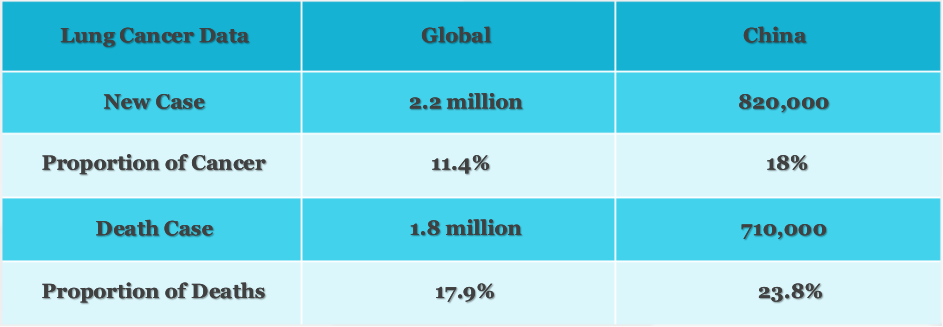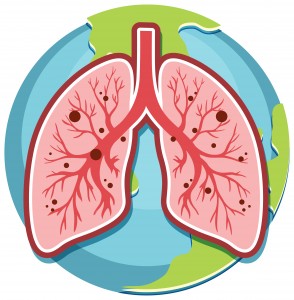According to the relevant data of the International Agency for Research on Cancer (IARC) of the World Health Organization (WHO), lung cancer has become one of the most serious malignant tumors, and the prevention and treatment of lung cancer has become the top priority of cancer prevention and treatment.
According to relevant statistical data, only about 20% of non-small cell lung cancer patients can undergo curative surgical treatment. The majority of lung cancer patients are already in the advanced stages when diagnosed, and they may derive limited benefits from traditional radiotherapy and chemotherapy treatments. With the continuous progress and development of medical science, the emergence of ablative therapy as a substitute for surgery has brought new treatment hope for lung cancer patients.
1. How much do you know about ablative therapy for lung cancer?
Ablative therapy for lung cancer mainly includes microwave ablation and radiofrequency ablation. The treatment principle involves inserting an ablative electrode, also known as a “probe,” into the tumor in the lung. The electrode can cause rapid movement of particles such as ions or water molecules within the tumor, generating heat due to friction, leading to irreversible damage such as coagulative necrosis of tumor cells. At the same time, the speed of heat transfer decreases rapidly in the surrounding normal lung tissue, preserving the heat within the tumor, creating a “thermal insulation effect.” Ablative therapy can effectively kill the tumor while maximizing the protection of normal lung tissue.
Ablative therapy is characterized by its repeatability, minimal patient discomfort, small trauma, and quick recovery, and has been widely recognized and used in clinical practice. However, considering that ablative therapy involves multiple disciplines such as radiology, oncology, interventional radiology, and surgical anatomy, it requires a high level of surgical skills and comprehensive qualities from the operating physician.
Today, we would like to introduce to you a renowned expert in the field of interventional treatment, Dr. Liu Chen, who has been working in the field for many years and is dedicated to the clinical translational research and standardized popularization of minimally invasive interventional diagnostics and treatments such as challenging and high-risk tumor biopsies, thermal ablation, and particle implantation. Dr. Liu is known as the “hero on the needle tip” and has participated in the formulation of expert consensus and guidelines for various interventional treatment techniques for lung cancer in China. He has pioneered the concept of comprehensive management of lung cancer biopsies and established standardized surgical procedures to improve the decision-making of interventional treatment in local therapy for early-stage lung cancer, promoting the overall development of China’s lung cancer diagnosis and treatment system.
“Hero on the Needle Tip” – Doctor Liu Chen
Specializes in minimally invasive interventional diagnosis and treatment techniques for tumors under imaging guidance
1. Microwave/Radiofrequency ablation
2. Percutaneous biopsy
3. Radioactive particle implantation
4. Interventional pain management
2. Purpose and indications of ablative therapy for lung cancer
The “Expert Consensus on Ablative Therapy for Primary and Metastatic Lung Tumors” (2014 edition) divides ablative therapy for lung cancer into two categories: curative and palliative.
Curative ablation aims to completely necrotize the local tumor tissue and may achieve a curative effect. Early-stage lung cancer is an absolute indication for ablative therapy, especially for patients with poor cardiopulmonary function, advanced age, inability to tolerate surgery, refusal to undergo surgical resection, or those with a single tumor recurrence after conformal radiotherapy, as well as some patients with multiple primary lung cancer lesions who need to preserve lung function.
Palliative ablation aims to maximally inactivate the primary tumor in patients with advanced-stage lung cancer, reducing tumor burden, relieving symptoms caused by the tumor, and improving the patient’s quality of life. For patients with advanced-stage lung cancer, tumors with a maximum diameter >5 cm or with multiple lesions can undergo multi-needle, multipoint, or multiple treatment sessions, or be combined with other treatment methods to prolong survival. For late-stage malignant lung metastases, if the control of extrapulmonary tumors is good and only a small number of residual metastatic lesions exist in the lungs, ablative therapy can effectively help control the disease and improve the patient’s quality of life.
3. Advantages of ablative therapy
Minimally invasive surgery, quick recovery: Ablative therapy is considered a minimally invasive interventional surgery. The ablative electrode needle used typically has a diameter of 1-2mm, resulting in small surgical incisions the size of a needle hole. This approach offers advantages such as minimal trauma, less pain, and faster recovery.
Short surgical time, comfortable experience: Ablative therapy is commonly performed under local anesthesia or combined with intravenous sedation, eliminating the need for endotracheal intubation. Patients are in a light sleep state and can be easily awakened with a gentle tap. Some patients may feel like the surgery is completed after a quick nap.
Simultaneous biopsy for accurate diagnosis: During ablative therapy, a coaxial guidance or synchronous puncture biopsy instrument can be utilized to obtain a biopsy of the lesion. Subsequent pathological diagnosis and genetic testing provide valuable information for subsequent treatment decisions.
Repeatable procedure: Numerous studies from both domestic and international sources have shown that the local control rate of early-stage lung cancer patients undergoing ablative therapy is comparable to that of surgical resection or stereotactic radiation therapy. In the case of local recurrence, ablative therapy can be repeated multiple times to regain control of the disease while maximizing the patient’s quality of life.
Activation or enhancement of immune function: Ablative therapy aims to kill tumor cells within the body, and in some cases, it can activate or enhance the patient’s immune function, leading to a where untreated tumors in other parts of the body show regression. Additionally, ablative therapy can be combined with systemic medication to produce a synergistic effect.
Ablative therapy is particularly suitable for patients who are unable to tolerate surgical resection or general anesthesia due to poor cardiopulmonary function, advanced age, or multiple underlying comorbidities. It is also a preferred treatment for patients with early-stage multiple nodules (such as multiple ground-glass nodules).
Post time: Aug-23-2023



